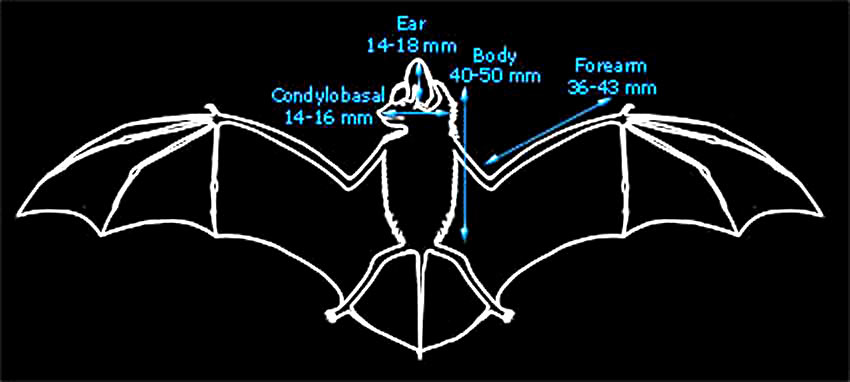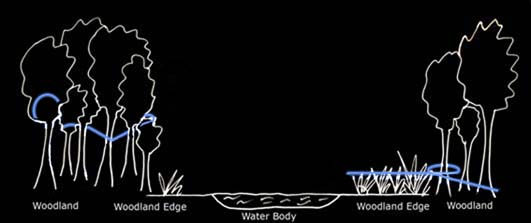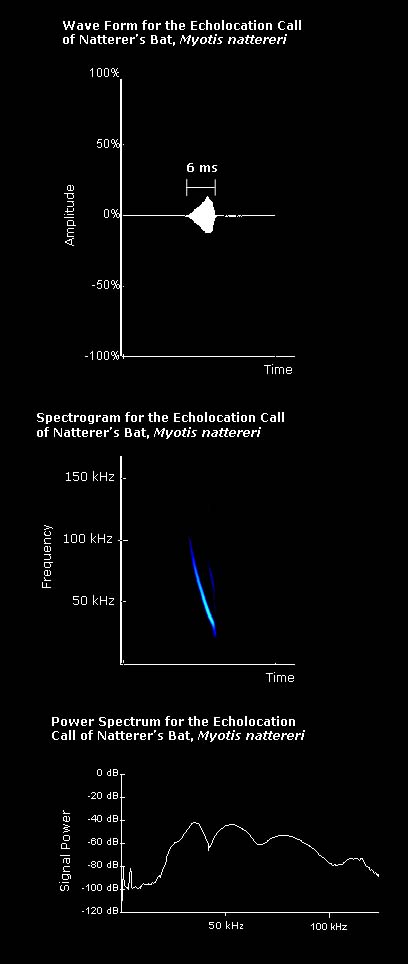Morphological Description
Life History
Distribution
Habitat
Roost Sites and Roosting Patterns
Emergence and Flight Pattern
Foraging Behaviour
Echolocation Calls
Status and Protection |
|
|
Morphological Description
- Dorsal fur is grey with a trace of brown. Ventral fur is a pale white-grey. There is an obvious division between the dorsal and ventral sides.
- Fur is long and woolly or fluffy.
- Juveniles have a more brown colouring.
- Tail membrane has a row of stiff bristles along its edge.
- Adult males have a short, blunt penis.
- Average weight (as given by Greenaway & Hutson, 1990) 6.5-12 g.
The diagram below gives important average body measurements for Natterer's bats (Greenaway & Hutson, 1990).
|

Back to top |
Life History
- Mate from autumn through to spring.
- One young is born between the end of June and the beginning of July (Stebbings, 1991b).
- Maximum age recorded in Europe is 20 years (Schober & Grimmberger, 1989).
Back to top
|
Distribution |
|
|
 |
| The British and World distributions are shown by the white areas of the maps above (as given by Richardson, 2000 and Corbet & Harris, 1991 respectively). |
|
Common in southern Britain.
Back to top
|
Habitat |
|
• Open woodland and parks; water with dense vegetation.
• Natterer's bats tend to forage in semi-natural broad-leaved woodland and along tree-lined rives and ponds (Smith & Racey, 2002). They may also use grassland habitats, flying very low over the ground.
• The photograph on the left shows a typical habitat of Natterer's bats.
|
| Roost Sites and Patterns |
- Summer roosts:
Nursery roosts contain 30-200 females and sometimes some males (Greenaway & Hutson, 1990).
Roost in buildings (crevices or roof spaces) and trees.
- Sometimes use bat boxes.
- Winter roosts: Natterer's bat are found singly or in small groups in cave-like environments from late December through to the end of February. Natterer's bats are the species most commonly found in cool regions of cave-like environments (Greenaway & Hutson, 1990).
May form small clusters with Daubenton's bats. Natterer's bats are usually found in crevices, sometimes lying on their back or resting on their head. May also roost low down and in scree or hanging from the roof or
walls.
Back to top
|
Emergence and Flight Pattern |
- Emerges in late dusk and returns to the roost one or two hours before sunrise (Stebbings, 1991b).
- Median emergence time is 75 minutes after sunset (Jones & Rydell, 1994).
- Flight is low and slow.
- Natterer's bats are agile fliers and can also hover for short periods of time.
Back to top
|
Foraging Behaviour |
- Forages throughout the night, often low over water (but usually higher than Daubenton's bats) with sharp turns. May also forage among tree branches in woodland, again using sudden turns.
- Natterer's bats are unusual in that they forage extremely close to vegetation (Smith & Racey, 2002). Natterer's bats can glean prey from surfaces and can also catch prey that is flying or hanging within a few centimetres of vegetation. Prey is generally eaten in flight.
- By using a very large bandwidth frequency-modulated echolocation call, Natterer's bats are able to locate prey within a few centimetres of echo-cluttering vegetation. This allows Natterer's bats to access prey items hanging from vegetation, such as spiders and caterpillars (Siemers & Schnitzler, 2000).
- Natterer's bats can locate prey in uncluttered environments by using only cues gained from echolocation. However, in cluttered environments they may use associative learning and feeding buzzes emitted by conspecifics in additional to echolocation cues. Natterer's bats fly low when foraging, hover, and then use their interfemoral membrane to capture the prey. Natterer's bats have also been seen to land and then chase prey items on the ground. Prey is eaten either in flight or at a perch. (Swift & Racey, 2002).
- The diet of Natterer's bats mainly consists of diurnal Diptera, which are gleaned from surfaces (Vaughan, 1997). Natterer's bats may also catch a few prey items by hawking.
- A study by Swift and Racey (2002) showed that the major dietary component of Natterer's bats was medium-sized arthropods (with a body length of 5-15mm), including harvestmen, spiders, beetles and dung-flies. Some of these prey items must have been obtained by gleaning as they are found on plant surfaces. Moths were available but were not eaten, suggesting either that Natterer's bats are unable to hear them or that the moths detected and avoided the bats (Swift & Racey, 2002).
- A study by Sheil et al. (1991) on a population of Natterer's bats in western Ireland showed that 68% of their diet was made up of insects which were probably gleaned from various surfaces such as foliage and the ground. The prey are thought to have been gleaned because they were insects that were diurnal or rarely flew, or non-flying arthropods. Ground-dwelling prey such as centipedes and the dipteran muscid Scatophaga stercoraria appeared to be common dietary components. The majority of prey items were larger Diptera, although Arachnida, Trichoptera and Hymenoptera were also common.
|
 |
|
Marked in blue on the diagram above is a typical foraging path of Natterer's bats (based on Russ, 1999).
Back to top
|
Echolocation Calls |
|
|
 |
The echolocation call of Natterer's bats is frequency modulated. |
|
To listen to the call of the Natterer's bat click here
Size of sound file: 31.4 KB
|

|
| For details of how the echolocation calls were recorded click here. |
|
Average values for a Natterer's bat echolocation call, as given by Vaughan et al. (1997), are listed below:
Interpulse interval: 67.1 ms
Call duration: 4.49 ms
Minimum frequency: 31.1kHz
Maximum frequency: 70.7 kHz
The spectrogram on the left shows clear frequency modulation, with the call beginning at high frequency and ending at a lower frequency.
|
Back to top
|
|
| Status and Protection
- The British pre-breeding population was estimated at 100,000 in 1995 (70,000 in England, 17,500 in Scotland and 12,500 in Wales) (Harris et al., 1995).
- Relatively common throughout Britain but threatened by loss of roost sites through tree felling, treatment of timber and destruction of winter roost sites.
- Natterer's bats are at low risk of extinction worldwide (IUCN status, 2001).
- Smith and Racey (2002) suggest that old heavily timbered barns and churches and old farmhouses should be conserved as they provide important roost sites for Natterer's bats. Mature trees in field margins should be protected for the same reason.
- Natterer's bats exhibit swarming behaviour at sites within 25 km of their day roost (Parsons & Jones, 2003). The swarming sites studied by Parsons and Jones had a minimum catchment area of 254 square km and are probably important for outbreeding. Natterer's bats generally use swarming sites in broad-leaved woodland and they appear to be faithful to a single site. It is therefore essential that these swarming sites are conserved.
Back to top
|
 © School of Biological Sciences, University of Bristol 2005. Last modified 24th February 2005. © School of Biological Sciences, University of Bristol 2005. Last modified 24th February 2005. |





 © School of Biological Sciences, University of Bristol 2005. Last modified 24th February 2005.
© School of Biological Sciences, University of Bristol 2005. Last modified 24th February 2005.